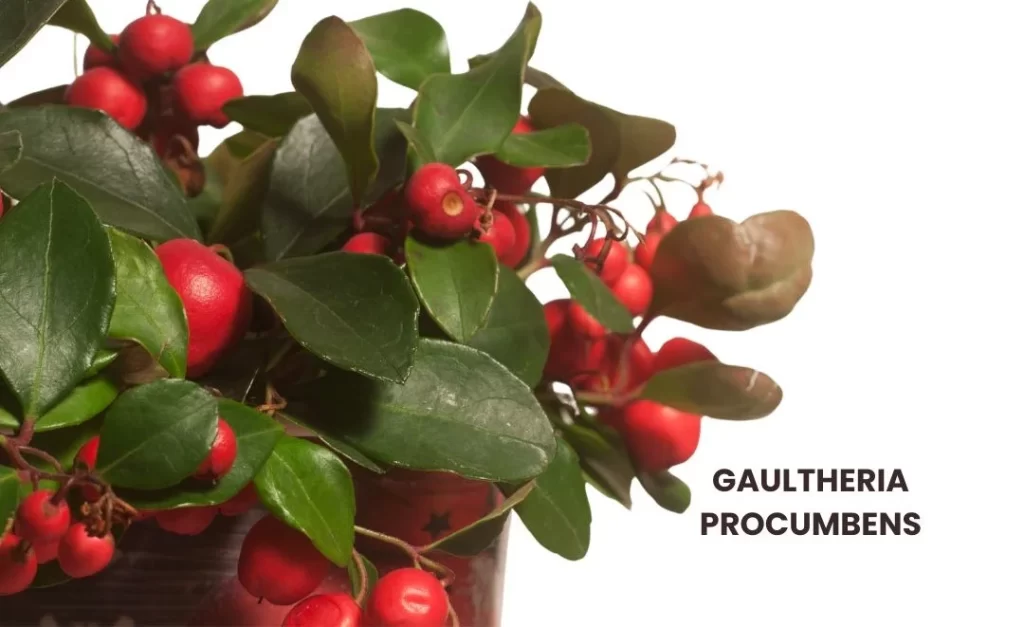Gaultheria procumbens, commonly known as Wintergreen, is a plant widely recognized for its medicinal properties.
It is frequently used in homeopathy for treating a variety of inflammatory and neuralgic conditions, as well as gastrointestinal and skin issues.
This remedy is particularly effective in managing rheumatic pain, sciatica, and other neuralgias.

Table of Contents
ToggleDETAILED SOURCE INFORMATION
Scientific Classification
- Kingdom: Plantae
- Clade: Angiosperms
- Clade: Eudicots
- Order: Ericales
- Family: Ericaceae
- Genus: Gaultheria
- Species: G. procumbens
Origin
- Gaultheria procumbens is native to North America, specifically the eastern regions of the United States and Canada.
- It thrives in woodland areas, preferring acidic and well-drained soils.
- Wintergreen is a low-growing, evergreen shrub that produces small, white to pinkish flowers and bright red berries.
Historical Facts
- Traditional Use: Indigenous peoples of North America traditionally used Wintergreen for its analgesic and anti-inflammatory properties.
- The leaves were often chewed to relieve pain, and teas made from the plant were used to treat respiratory and gastrointestinal issues.
- Homeopathic Introduction: Wintergreen was introduced into homeopathic practice in the 19th century.
- Its effectiveness in treating rheumatic and neuralgic pain, as well as its use in managing inflammation and skin conditions, made it a valuable remedy.
DRUG PATHOGENESIS
Wintergreen’s primary actions in homeopathy involve the management of pain, inflammation, and irritation.
It acts on the musculoskeletal system, gastrointestinal tract, and skin, providing relief from a range of symptoms associated with these systems.
KEY CHARACTERISTICS
- Anti-inflammatory: Effective in reducing inflammation, particularly in rheumatic conditions.
- Analgesic: Provides significant pain relief in conditions like sciatica, neuralgia, and pleurodynia.
- Gastrointestinal Relief: Addresses issues like acute gastritis and uncontrollable appetite despite gastric irritation.
- Skin Conditions: Alleviates burning and smarting sensations on the skin, often associated with intense erythema.
DETAILED ORGAN SYMPTOMS
HEAD
- Neuralgia: Sharp, intermittent pain in the head and face, often associated with nerve irritation.
STOMACH
- Acute Gastritis: Severe pain in the epigastrium, which is the upper central part of the abdomen.
- Prolonged Vomiting: Persistent vomiting that is difficult to control.
- Uncontrollable Appetite: A strong desire to eat, even when the stomach is irritated and inflamed.
- Gastralgia: Pain in the stomach due to nervous depression.
SKIN
- Smarting and Burning: Intense sensations of burning and stinging on the skin.
- Erythema: Redness of the skin, which is aggravated by cold bathing but improved with olive oil application and cool air.
MODALITIES
- Worse: Symptoms worsen with cold bathing.
- Better: Symptoms improve with the application of olive oil and exposure to cool air.
WHAT ARE MODALITIES IN HOMOEOPATHY?
RELATIONSHIP WITH OTHER DRUGS
Comparison
- Spiraea: Another remedy for rheumatic and neuralgic pains.
- Gaultheria contains Arbutin and Salicylic Acid: Active compounds similar to those found in other anti-inflammatory and analgesic remedies.
- Methylium Salicylicum: An artificial Gaultheria oil used for rheumatism, especially when salicylates cannot be used, and for conditions like pruritus and epididymitis locally.
- Cantharis: Often used after burns to provide relief from pain and inflammation.
DOSE
- Tincture and Lower Potencies: Gaultheria procumbens is typically administered in tincture form or in lower homeopathic potencies.
- The appropriate dosage should be determined by a qualified homeopath based on the individual’s specific symptoms and overall health condition.
Frequently Asked Questions (FAQs)
What conditions can Gaultheria procumbens treat?
- Gaultheria procumbens is used to treat inflammatory rheumatism, neuralgia, sciatica, acute gastritis, uncontrollable appetite despite stomach irritation, and various skin conditions like erythema and burning sensations.
Is Gaultheria procumbens safe to use?
- When used in homeopathic dilutions as prescribed by a qualified homeopath, Gaultheria procumbens is safe.
- It is important to follow the dosage instructions carefully to avoid any adverse effects.
How is Gaultheria procumbens prepared in homeopathy?
- The remedy is prepared through a process of serial dilution and succussion (vigorous shaking), which creates a highly diluted solution that retains the therapeutic properties of the plant without its toxic effects.
Can Gaultheria procumbens be used for both acute and chronic conditions?
- Yes, it can be used to treat both acute and chronic conditions, particularly those related to pain, inflammation, gastrointestinal issues, and skin conditions.
Glossary of Difficult Words
- Neuralgia: Intense, typically intermittent pain along the course of a nerve.
- Epigastrium: The upper central region of the abdomen.
- Gastralgia: Pain in the stomach or epigastric region.
- Erythema: Redness of the skin caused by increased blood flow.
- Pleurodynia: Pain in the muscles between the ribs or in the diaphragm.
This detailed overview of Gaultheria procumbens (Wintergreen) provides a comprehensive understanding of its origin, historical use, and specific applications in homeopathy, along with a clear description of the symptoms it addresses and how it is prepared and administered.
